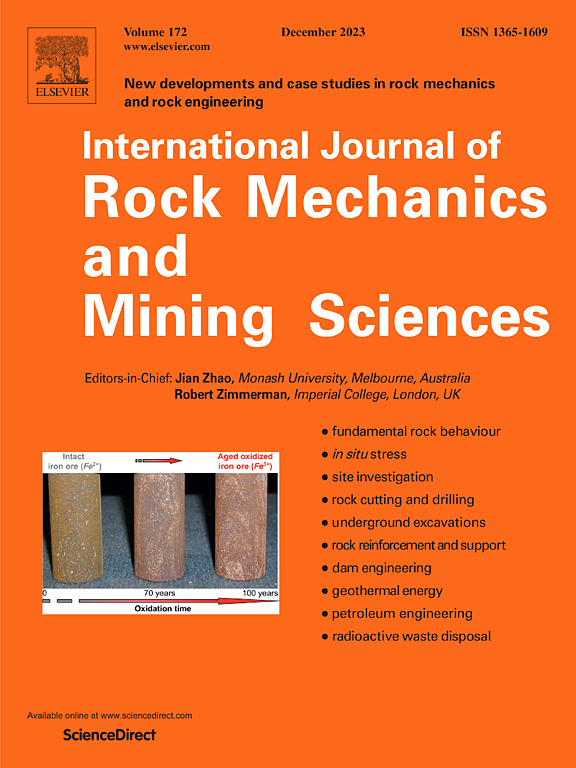Erosion characteristics of hydrate-bearing sediments exposed to a cavitation jet
IF 7.5
1区 工程技术
Q1 ENGINEERING, GEOLOGICAL
International Journal of Rock Mechanics and Mining Sciences
Pub Date : 2025-04-14
DOI:10.1016/j.ijrmms.2025.106118
引用次数: 0
Abstract
Natural gas hydrate (NGH) is a potential alternative source of energy for the future, and the low mining efficiency severely restricts its commercial utilization. Recently, the cavitation jet technology has been emerging as a prospective way of drilling rate improvement for the industrial development of NGH. The breaking and mining efficiency of cavitation jet is strongly associated with the nozzle structures. In this research, the structure parameters of angular cavitation water jet (ACWJ) nozzle are optimized to maximize the cavitation initiation range and thereby the cavitation damage effect, using the computational fluid dynamics (CFD) method. Then, the erosion experiments of synthetic hydrate-bearing sediments (HBS) samples under various standoff distances, inlet flow rates, and erosion times are conducted with the optimized ACWJ nozzle. Finally, the grey relational analysis method is utilized to reveal the sensibilities of the nozzle structure parameters to the cavitation clouds initiation, and the hydraulic conditions to the erosion performance of ACWJ. Results show that divergent part structure greatly enhances the cavitation erosion ability of ACWJ, and the optimized divergent length and angle are 2d and 34°, respectively. Under present experimental conditions, the volume and depth of erosion pits achieve the highest values when the standoff distance is about 5 times the throat diameter of ACWJ nozzle. The threshold velocity of the ACWJ breaking HBS with 50 % hydrate saturation is estimated as 20 m/s∼25 m/s according to the fitting curves. The development process of erosion pit erosion by an ACWJ is revealed, and an erosion pit enlargement stage occurs because of the damage effect caused by cavitation bubbles. This work gives some meaningful findings and provides promising guidance for the field application of cavitation jet in NGH drilling and mining.

暴露于空化喷流的含水沉积物的侵蚀特征
天然气水合物是未来潜在的替代能源,但开采效率低严重制约了其商业化利用。近年来,空化射流技术已成为天然气水合物工业发展中提高钻井速度的一种有前景的方法。空化射流的破碎和开采效率与喷嘴结构密切相关。本研究采用计算流体力学(CFD)方法,对角空化水射流(ACWJ)喷嘴的结构参数进行优化,使空化起爆范围最大化,从而使空化损伤效果最大化。然后,利用优化后的ACWJ喷嘴,对合成含水沉积物(HBS)样品进行了不同距离、不同进口流量、不同冲刷次数的冲刷实验。最后,利用灰色关联分析方法揭示了喷嘴结构参数对空化云起爆的敏感性,以及水力条件对ACWJ冲蚀性能的影响。结果表明,发散部分结构大大提高了ACWJ的空化冲刷能力,优化后的发散长度为2°,发散角度为34°。在本实验条件下,当距离为ACWJ喷管喉道直径的5倍左右时,侵蚀坑的体积和深度达到最大值。根据拟合曲线估计,当水合物饱和度为50%时,ACWJ破断HBS的阈值速度为20 m/s ~ 25 m/s。揭示了ACWJ侵蚀坑的发展过程,由于空化气泡的破坏作用,出现了侵蚀坑扩大阶段。本工作取得了一些有意义的成果,为空化射流在天然气水合物钻井开采中的现场应用提供了良好的指导。
本文章由计算机程序翻译,如有差异,请以英文原文为准。
求助全文
约1分钟内获得全文
求助全文
来源期刊
CiteScore
14.00
自引率
5.60%
发文量
196
审稿时长
18 weeks
期刊介绍:
The International Journal of Rock Mechanics and Mining Sciences focuses on original research, new developments, site measurements, and case studies within the fields of rock mechanics and rock engineering. Serving as an international platform, it showcases high-quality papers addressing rock mechanics and the application of its principles and techniques in mining and civil engineering projects situated on or within rock masses. These projects encompass a wide range, including slopes, open-pit mines, quarries, shafts, tunnels, caverns, underground mines, metro systems, dams, hydro-electric stations, geothermal energy, petroleum engineering, and radioactive waste disposal. The journal welcomes submissions on various topics, with particular interest in theoretical advancements, analytical and numerical methods, rock testing, site investigation, and case studies.

 求助内容:
求助内容: 应助结果提醒方式:
应助结果提醒方式:


